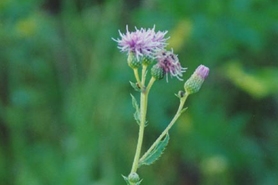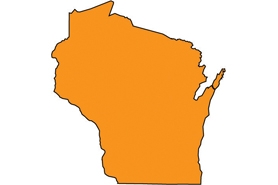Canada thistle
(Cirsium arvense)
Herbaceous perennial, 2-6.5' tall with upright, grooved stems that branch near the top of the plant. The stems are hairy.
Other names for this plant include:
- Common names: creeping thistle, field thistle, perennial thistle
- Scientific names: Carduus arvensis; Cirsium incanum
Classification in Wisconsin: Restricted
- Ecological Threat
-
- It invades undisturbed areas such as prairies, savannas, glades, dunes, streambanks, sedge meadows and forest openings. It also invades croplands, pastures, lawns, gardens, roadsides, ditches and waste sites.
- Once it has established it spreads quickly, forming monocultures.
- Identification
-
Leaves: Simple, alternate, lance-shaped, tapering, irregularly lobed, with spiny, toothed margins, stalkless. Green on both sides; smooth early but becoming pubescent with maturity.
Flowers: Numerous small (0.5-0.75" wide), purple to pink (rarely white) terminal flower heads. Bracts have spineless tips. Blooms June-September.
Fruits & seeds: Small, light brown with a tuft of tan hairs loosely attached to the tip to enable wind dispersal. Seeds are often spread by mowing after flowering has begun.
Roots: Reproduces clonally by creeping roots that grow laterally in soil, up to 10-12' per year. It also produces taproots that may grow more than 6' deep. Readily regenerates from root fragments.
Similar species: Canada thistle is distinguished from all other thistles by creeping lateral roots, dense clonal growth, and small dioecious flower heads (meaning male and female flowers are produced on separate plants). However, it isn't easy to distinguish the two flower types based on appearance.
Other invasive thistles include the European marsh thistle (Cirsium palustre).
- Control
-
Mechanical: Repeated pulling and mowing (minimum three times per growing season) weakens roots; mow when flower buds are formed but have not yet opened. Late spring (May/June) burns for three consecutive years stimulates seed germination and kills seedlings. Later-season burns are needed because early-season burning can stimulate plant growth and flowering.
Chemical: Foliar spray glyphosate during the early bolting phase when plants are 6-10" tall, during the bud-to-flower phase, or rosettes in the fall; foliar spray with clopyralid or metsulfuron-methyl.
Biological: Stem weevil (Ceutorhynchus litura), bud weevil (Larinus planus), stem gall fly (Urophora cardui), and foliage feeder (Cassida rubiginosa).
For more information on control techniques, visit the Canada thistle factsheet [exit DNR] by the University of Wisconsin-Extension.
- Resources
- Sources for content:
- Czarapata, Elizabeth; Invasive Plants of the Upper Midwest: an illustrated guide to their identification and control. The University of Wisconsin Press. 2005. Pg. 55-57
- McClay, A.S. Canada thistle In Van Driesche, R., et al., 2002, Biological Control of Invasive Plants in the Eastern United States, USDA Forest Service Publication FHTET-2002-04, 413 p [exit DNR]. Last updated Nov. 5, 2003.
- Virginia Tech Weed Identification Guide. Canada thistle (Cirsium arvense) [exit DNR].


